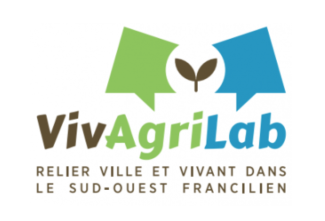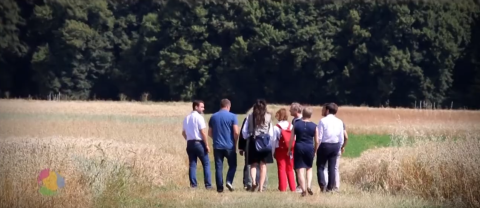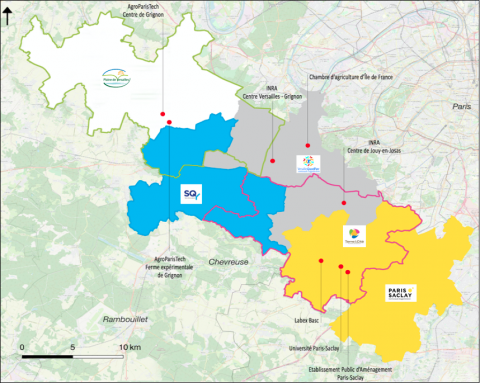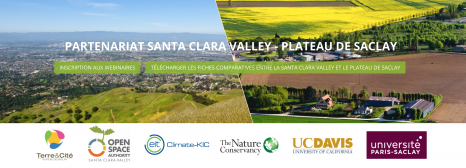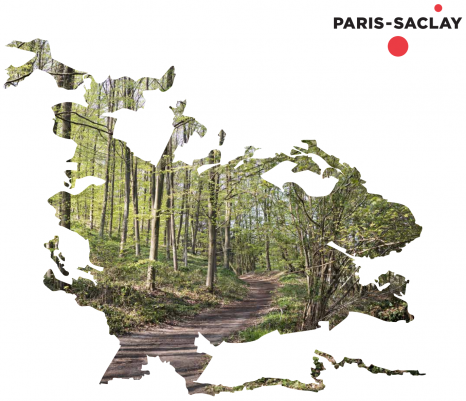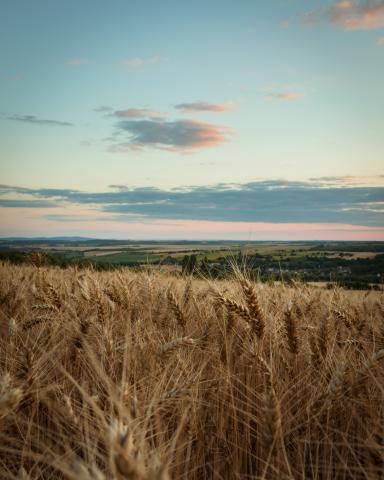
Multi-stakeholder platform for the transition of the territory
Fostering sustainability in periurban territories is the transversal axis of research and innovation of C-BASC. The territory around the university is one of our fields of experimentation and observation. It is undergoing major changes because of the construction of the cluster composed of the university, companies... The genericity of concepts and methodologies will be explored by comparing and sharing with other regions in France and abroad including the Global South.
Bipartisan to multi-stakeholder collaboration
In 2013, the Terre et Cité association and LabEx BASC (the original structure of C-BASC) initiated workshops to encourage the co-construction of research with local players, focusing on the preservation and management of agricultural and natural areas on and around the Plateau de Saclay. We have carried out a dozen applied research projects, supported in particular by the European LEADER program, which are explained in video (in french). The Territorial Ecology workshops of the Plateau de Saclay in 2016 were a highlight ; the report is available in French.
In this vein, we are participating in the development of a living lab called "VivAgriLab: linking city and living in the south-west of the Paris region". VivAgriLab is a platform for dialogue aimed at fostering the emergence of applied research projects in a wide area around the university, to promote the sustainability of agriculture, food systems and nature. In 2018 a prefiguration day of the living lab was held at INRAE Versailles, explained on video (in french).
An extended peri-urban territory
The VivAgriLab living lab is made up of the following founding members:
- 3 associations running an agri-urban program supported by the region since 2005: Terre & Cité, APPVA, Triangle Vert,
- 3 agglomeration communities: Saint Quentin en Yvelines, Versailles Grand Parc and Paris-Saclay.
- the Ile-de-France Chamber of Agriculture and
- local research and higher education organizations: INRAE, AgroParisTech, C-BASC and, more broadly, the Université Paris-Saclay.
- the Etablissement public d'aménagement de Paris-Saclay,
These institutions meet several times a year in a Technical Committee and a Steering Committee. VivAgriLab's territory corresponds to the area covered by the 3 associations and 3 agglomeration communities (see map below). The Terre & Cité association is leading the process, with the help of C-BASC.
VivAgriLab received its first grant at the end of 2020, from the Fondation de France, for a project focused on creating a circular economy for food and organic matter flows at local level, in order to contribute to territorial sustainability (Flux local project).
Annual meetings between researchers and local players
Every year, the living lab VivAgriLab organizes a meeting between researchers and local players, open to all local players and partners. The workshops that punctuate these days aim either to present the results of past projects, or to initiate a process of co-designing new applied research projects. Themes of common interest emerge in the course of discussions. The next meeting will take place on December 12, 2023 (this will be the 4th VivAgriLab event). Registration is now open! C-BASC called on researchers to lead a workshop on a topic of their choice at the December 12, 2023 event (deadline October 19, 2023). Read the minutes of the February 2022 and December 2022 meetings. C-BASC invests in VivAgriLab to deepen interdisciplinarity and co-design, with the aim of generalizing results. Discover the projects C-BASC funds around the university, some of which are linked to VivAgriLab.
The Living Lab territory
Other projects of the Saclay Plateau
Partnership with the Santa Clara Valley
California's Santa Clara Valley (≈ Silicon Valley) and the Plateau de Saclay southwest of Paris share similar opportunities and challenges. They have had to devise innovative and exceptionally robust mechanisms to control urban pressure around major metropolises in order to maintain the agricultural and natural landscapes that have made their identity and quality of life. These two poles of research and innovation are called upon to invent new synergies that can emerge between cities, agriculture and nature.
Their collaboration on sustainability issues began in 2018, with the visit of a delegation from the plateau to the Santa Clara Valley. Following this, the University of Paris-Saclay, the University of California at Davis, Terre et Cité (T&C), the Santa Clara Valley Open Space Authority (OSA), The Nature Conservancy (TNC), and EIT Climate KIC partnered to offer a series of video conferences on the resilience of peri-urban natural, agricultural, and forested areas in light of climate change and biodiversity loss. Institutional actors, researchers, farmers and other stakeholders from the Plateau de Saclay and Silicon Valley interact to reflect together on public policies for the protection and restoration of open spaces, their concrete application in the territories and the role of research in this regard. You can still watch the webinars:
- Climate and Biodiversity Collapse (Jan 28, 2021)
- Land use and sustainability (Oct. 7, 2021), with the intervention of Yann Arthus-Bertrand and the Executive Secretary of IPBES.
- Carbon storage at farm and territory level (Nov. 18, 2021)
Consult the comparative sheets of the Santa Clara Valley and the Saclay Plateau elaborated by a PhD student: introductory booklet, international legislation, intergovernmental levels, international regulations, open space management. Others are planned: peri-urban and multi-benefit contexts, summary sheet and action guide.
In order to develop new joint actions, a Californian multi-stakeholder delegation came on a study tour from July 11 to 15, 2022, which included a public conference. C-BASC thanks the Terre & Cité association for the organization.
The Natural, Agricultural and Forestry Protection Zone
Created by law in 2010, the Natural, Agricultural and Forest Protection Zone (ZPNAF) of the Plateau de Saclay is the only zone of its kind on a national scale. It aims to preserve and revitalize more than 4,000 hectares of natural, agricultural and forest areas. The local actors have set up an action program. C-BASC is piloting action C23 entitled "Promoting interactions between research and local stakeholders in order to meet the crossroads of agricultural and environmental issues on the Saclay plateau". The 2019-2020 progress report on the action program is available.

